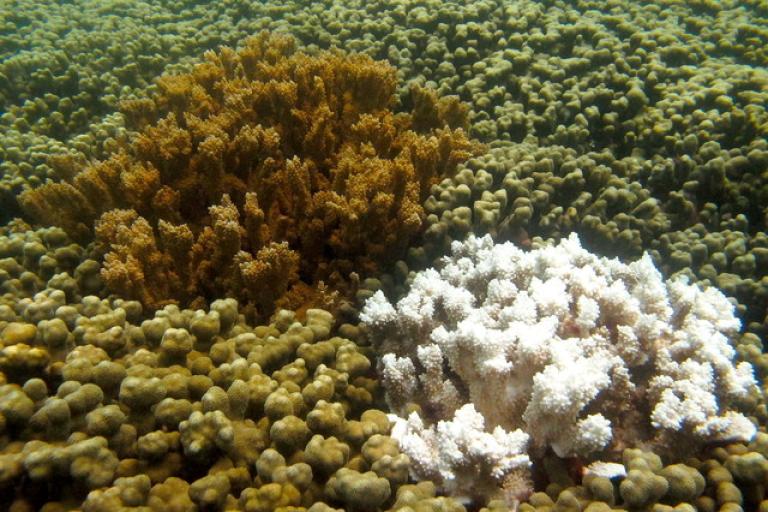Scientists assess the impacts of a warming ocean
With global average sea surface temperatures at record highs, ocean scientists associated with the WMO co-sponsored World Climate Research Programme have made a collective assessment of recent global trends and what may be expected in the future. This includes an observed basin-wide warming of the ocean and an increase in marine heatwaves.

Marine heatwaves occur when ocean temperatures in a given region are well above average for an extended period of time. Warmer ocean temperatures impact the marine environment and associated ecosystems, and ocean heat can also fuel developing tropical cyclones.
What’s behind the widespread extent of recent marine heatwaves?
Global monthly-mean ocean temperatures are currently at an all-time high relative to temperatures since the start of the instrumental record and potentially extending even further into the past, with 27% of the global ocean experiencing a marine heatwave as of August 15, 20231. The World Meteorological Organization recently announced that El Niño conditions have developed for the first time in seven years. Tropical Pacific surface temperatures are warmer during El Niño years as upper ocean heat content is redistributed from west to east across the Pacific, explaining the intense warming developing in the eastern equatorial Pacific. Besides the tropical Pacific, a recent study has shown that the most widespread marine heatwaves have occurred during major El Niño events. A region particularly affected by El Niño is the Northeast Pacific, which is also currently undergoing extremely warm conditions.
Other compelling reasons could explain recent warming in other regions. For example, the North Atlantic has experienced a sequence of marine heatwaves extending from the tropics to mid-latitudes. This warming pattern is consistent with the negative phase of the North Atlantic Oscillation, a natural pattern of atmospheric variability that can impact surface winds and influence ocean temperatures. The North Atlantic Oscillation was strongly negative from mid-April to mid-May 2023 and most of July, consistent with the observed Atlantic warming pattern. During this negative phase, less Saharan dust is blown over the tropical Atlantic Ocean, allowing more sunlight to reach the surface and warm the ocean. It is possible that there are additional local drivers of ocean warming. However, more data and research are needed to definitively identify the specific mechanisms of current marine heatwaves in different regions.
In addition to mechanisms related to natural variability of the climate system, we know that about 90% of the excess heat associated with global warming has been absorbed by the ocean, causing the global ocean surface temperature to increase by about 0.9°C since pre-industrial times. This long-term warming manifests as an intensification and persistence of ocean temperature extremes, by exacerbating the impact of internal climate variations like El Niño and the North Atlantic Oscillation. Therefore, it is very likely that climate change has contributed to the intensity and widespread coverage of current marine heatwaves.
How long will these marine heatwaves last?
Long-range seasonal forecasts and experimental marine heatwave forecasts predict continuing widespread warming over the coming months. Regionally, the latter forecasts indicate that marine heatwaves in the tropical Atlantic have a 50-80% chance of persisting into boreal winter 2023, although confidence in these forecasts generally decreases with increasing lead time. Additionally, models predict an elevated risk of marine heatwave conditions along the US west coast in boreal spring 2024 as the current El Niño continues to strengthen, since events usually peak in austral summer. See the full report for a breakdown of additional regions.
Impacts
Each year, marine heatwaves impact marine ecosystems around the globe, resulting in billions of US dollars in damages to marine ecosystems and to industries such as fisheries or tourism. During summer, marine heatwaves cause heat stress on a large variety of marine species including foundation species like seagrass, kelp and corals, with El Niño marine heatwave conditions particularly impactful on these species globally. For example, coral reefs off the Florida Keys have experienced an unprecedented level of coral bleaching this year. Aside from ecosystems, ocean heat is an important fuel source for developing tropical cyclones. Marine heatwaves in the tropical Indian Ocean contribute to rapidly intensifying cyclones and fluctuations in the monsoon rainfall. Extreme warming in the tropical Atlantic could contribute to stronger storms, although the influence of El Niño on upper-level winds may counteract the effect of the warm surface temperatures.
Due to ongoing global warming in response to unabated greenhouse gas emissions, instances of extreme ocean warming are projected to further increase in frequency, duration, and intensity. If dramatic mitigation and adaptation efforts do not occur, then each increment of future warming may lead to severe impacts on biodiversity, structure and function of marine ecosystems.
This assessment was made by the Marine Heatwaves in the Global Ocean Research Focus of the Climate and Ocean Variability, Predictability and Change (CLIVAR) Core Project of the World Climate Research Programme. The goal of the Research Focus is to achieve a better understanding of marine heat waves globally, including detection, surface and subsurface characteristics, mechanisms, connection with climate change and biogeochemical extremes, to increase preparedness and promote efficient adaptation planning, while contributing to the training of the next generation of scientists and providing input to observational programs.
Contact: Prof. Regina Rodrigues, regina [dot] rodrigues ufsc [dot] br (regina[dot]rodrigues[at]ufsc[dot]br)
ufsc [dot] br (regina[dot]rodrigues[at]ufsc[dot]br)










